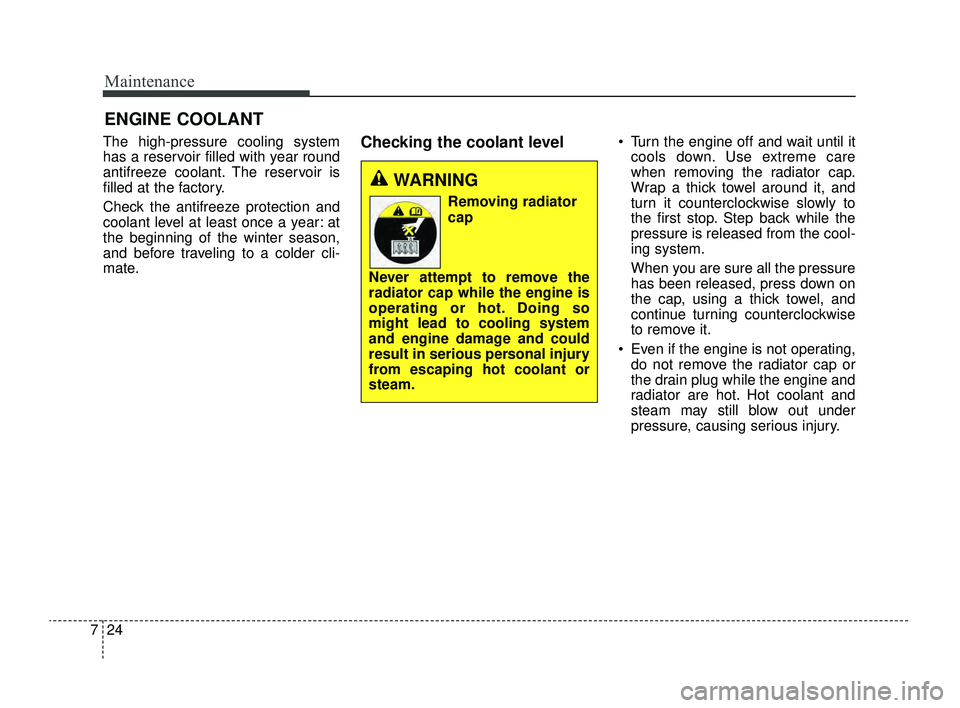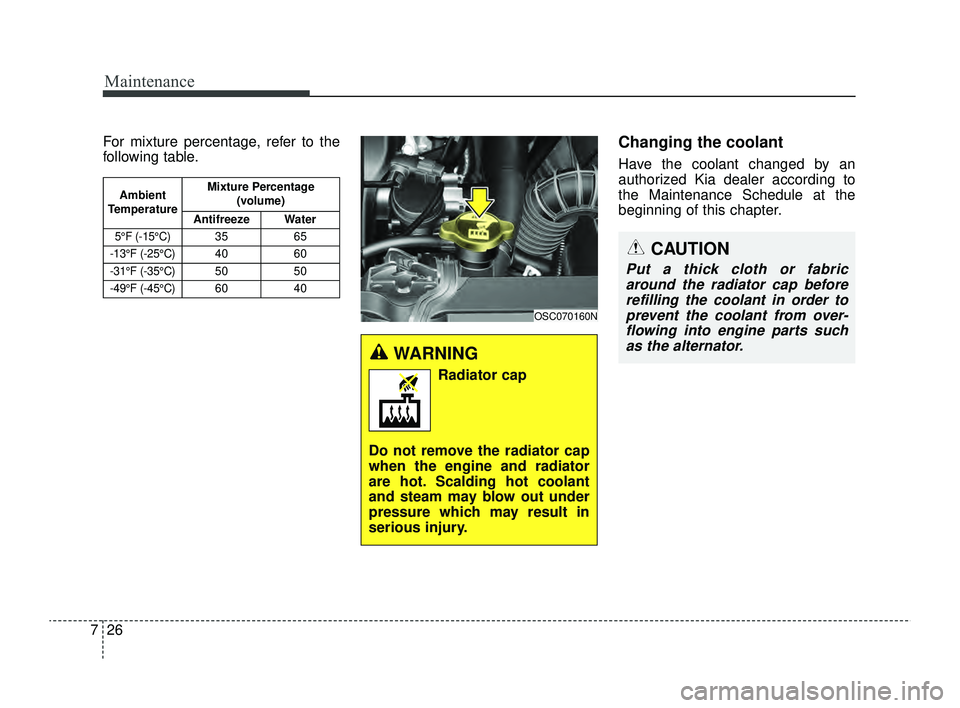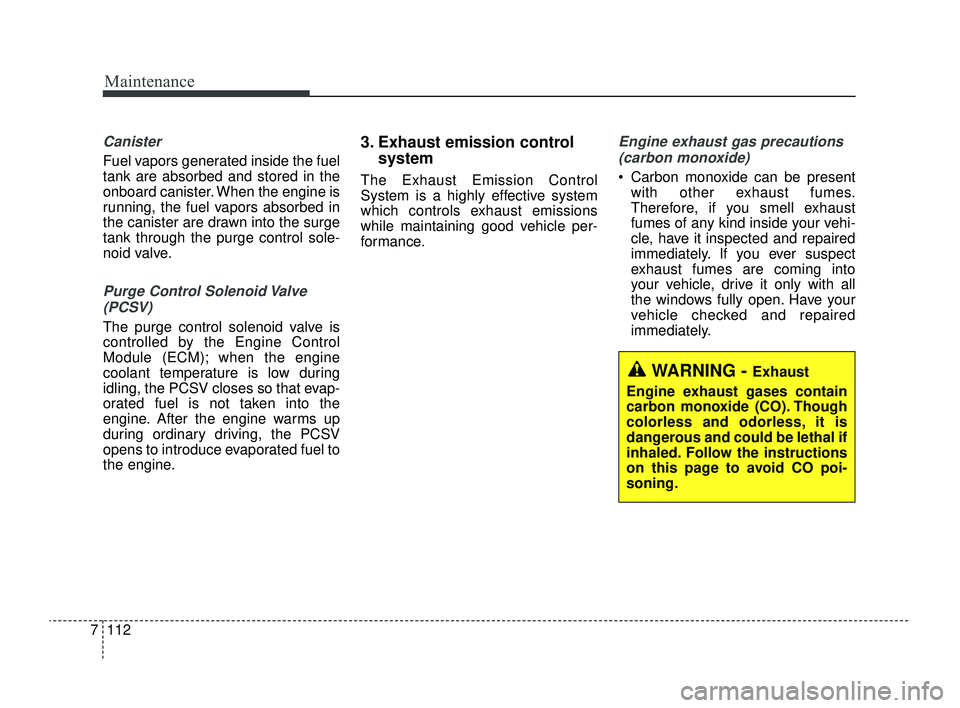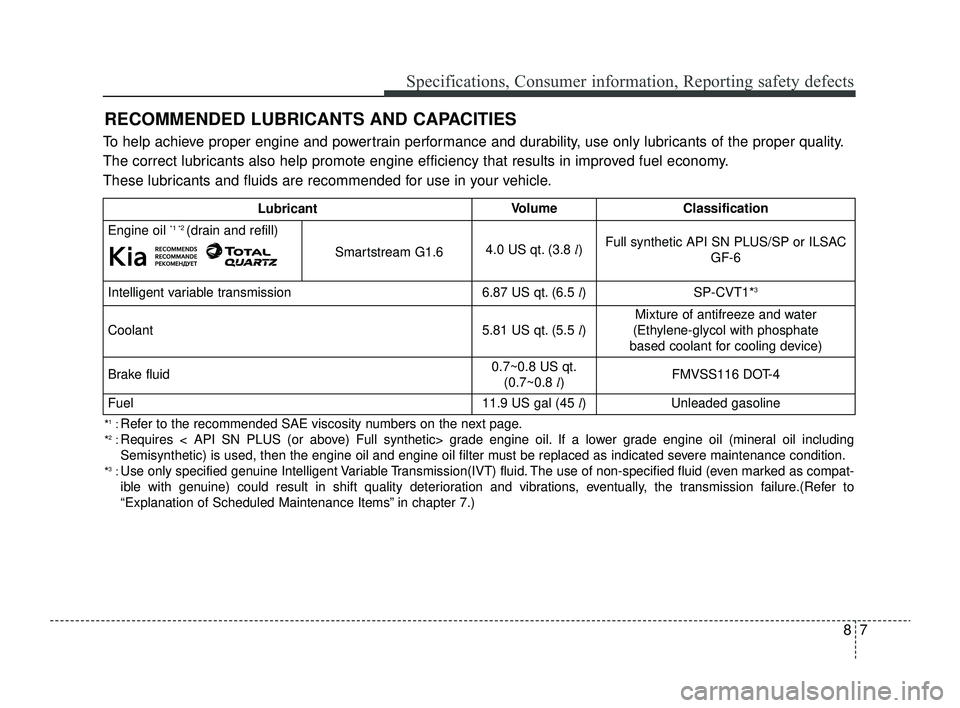2022 KIA RIO engine coolant
[x] Cancel search: engine coolantPage 411 of 528

Maintenance
24
7
ENGINE COOLANT
The high-pressure cooling system
has a reservoir filled with year round
antifreeze coolant. The reservoir is
filled at the factory.
Check the antifreeze protection and
coolant level at least once a year: at
the beginning of the winter season,
and before traveling to a colder cli-
mate.Checking the coolant level Turn the engine off and wait until it
cools down. Use extreme care
when removing the radiator cap.
Wrap a thick towel around it, and
turn it counterclockwise slowly to
the first stop. Step back while the
pressure is released from the cool-
ing system.
When you are sure all the pressure
has been released, press down on
the cap, using a thick towel, and
continue turning counterclockwise
to remove it.
Even if the engine is not operating, do not remove the radiator cap or
the drain plug while the engine and
radiator are hot. Hot coolant and
steam may still blow out under
pressure, causing serious injury.
WARNING
Removing radiator
cap
Never attempt to remove the
radiator cap while the engine is
operating or hot. Doing so
might lead to cooling system
and engine damage and could
result in serious personal injury
from escaping hot coolant or
steam.
SC PE USA 7.qxp 9/9/2021 6:26 PM Page 24
Page 412 of 528

725
Maintenance
Check the condition and connections
of all cooling system hoses and
heater hoses. Replace any swollen
or deteriorated hoses.
The coolant level should be filled
between F and L marks on the side
of the coolant reservoir when the
engine is cool.
If the coolant level is low, add enough
specified coolant to provide protec-
tion against freezing and corrosion.
Bring the level to F, but do not over-
fill. If frequent additions are required,
see an authorized Kia dealer for a
cooling system inspection.
Recommended engine coolant
When adding coolant, use onlydeionized water or soft water for
your vehicle and never mix hard
water in the coolant filled at the fac-
tory. An improper coolant mixture
can result in serious malfunction or
engine damage.
The engine in your vehicle has alu- minum engine parts and must be
protected by an ethylene-glycol
with phosphate based coolant to
prevent corrosion and freezing.
DO NOT USE alcohol or methanol coolant or mix them with the spec-
ified coolant.
Do not use a solution that contains more than 60% antifreeze or less
than 35% antifreeze. This would
reduce the effectiveness of the
solution.
✽ ✽
NOTICE
Make sure that the coolant cap is
properly closed after refilling the
coolant. Otherwise the engine could
overheat while driving.
OSC077016N
WARNING- Cooling fan
Use caution when working near
the blade of the cooling fan. The
electric motor (cooling fan) is
controlled by engine coolant
temperature, refrigerant pres-
sure and vehicle speed. it may
sometimes operate even when
the engine is not running.
SC PE USA 7.qxp 9/9/2021 6:26 PM Page 25
Page 413 of 528

Maintenance
26
7
For mixture percentage, refer to the
following table.Changing the coolant
Have the coolant changed by an
authorized Kia dealer according to
the Maintenance Schedule at the
beginning of this chapter.
OSC070160N
Ambient
Temperature Mixture Percentage
(volume)
Antifreeze Water
5°F (-15°C)35 65
-13°F (-25°C)4060
-31°F (-35°C)5050
-49°F (-45°C)6040
WARNING
Radiator cap
Do not remove the radiator cap
when the engine and radiator
are hot. Scalding hot coolant
and steam may blow out under
pressure which may result in
serious injury.
CAUTION
Put a thick cloth or fabric around the radiator cap beforerefilling the coolant in order toprevent the coolant from over-flowing into engine parts suchas the alternator.
SC PE USA 7.qxp 9/9/2021 6:27 PM Page 26
Page 499 of 528

Maintenance
112
7
Canister
Fuel vapors generated inside the fuel
tank are absorbed and stored in the
onboard canister. When the engine is
running, the fuel vapors absorbed in
the canister are drawn into the surge
tank through the purge control sole-
noid valve.
Purge Control Solenoid Valve
(PCSV)
The purge control solenoid valve is
controlled by the Engine Control
Module (ECM); when the engine
coolant temperature is low during
idling, the PCSV closes so that evap-
orated fuel is not taken into the
engine. After the engine warms up
during ordinary driving, the PCSV
opens to introduce evaporated fuel to
the engine.
3. Exhaust emission control system
The Exhaust Emission Control
System is a highly effective system
which controls exhaust emissions
while maintaining good vehicle per-
formance.
Engine exhaust gas precautions
(carbon monoxide)
Carbon monoxide can be present with other exhaust fumes.
Therefore, if you smell exhaust
fumes of any kind inside your vehi-
cle, have it inspected and repaired
immediately. If you ever suspect
exhaust fumes are coming into
your vehicle, drive it only with all
the windows fully open. Have your
vehicle checked and repaired
immediately.
WARNING - Exhaust
Engine exhaust gases contain
carbon monoxide (CO). Though
colorless and odorless, it is
dangerous and could be lethal if
inhaled. Follow the instructions
on this page to avoid CO poi-
soning.
SC PE USA 7.qxp 9/9/2021 6:31 PM Page 112
Page 508 of 528

87
Specifications, Consumer information, Reporting safety defects
RECOMMENDED LUBRICANTS AND CAPACITIES
LubricantVolumeClassification
Engine oil *1 *2 (drain and refill)
Smartstream G1.64.0 US qt. (3.8 l)Full synthetic API SN PLUS/SP or ILSAC
GF-6
Intelligent variable transmission6.87 US qt. (6.5 l)SP-CVT1*3
Coolant 5.81 US qt. (5.5 l)
Mixture of antifreeze and water
(Ethylene-glycol with phosphate
based coolant for cooling device)
Brake fluid0.7~0.8 US qt. (0.7~0.8 l)FMVSS116 DOT-4
Fuel11.9 US gal (45 l)Unleaded gasoline
To help achieve proper engine and powertrain performance and durability, use only lubricants of the proper quality.
The correct lubricants also help promote engine efficiency that results in improved fuel economy.
These lubricants and fluids are recommended for use in your vehicle.
*1:Refer to the recommended SAE viscosity numbers on the next page.
*2:Requires < API SN PLUS (or above) Full synthetic> grade engine oil. If a lower grade engine oil (mineral oil including
Semisynthetic) is used, then the engine oil and engine oil filter must be replaced as indicated severe maintenance condition.
*3:Use only specified genuine Intelligent Variable Transmission(IVT) fluid. The use of non-specified fluid (even marked as compat-
ible with genuine) could result in shift quality deterioration and vibrations, eventually, the transmission failure.(Refer to
“Explanation of Scheduled Maintenance Items” in chapter 7.)
SC PE USA 8.qxp 8/23/2021 5:30 PM Page 7
Page 520 of 528

Index
4I
Emission control system ..............................................7-111Crankcase emission control system ..........................7-111
Evaporative emission control (including ORVR: Onboard Refueling Vapor Recovery) system ........7-111
Exhaust emission control system ..............................7-112
Engine .................................................................\
...........8-2
Engine compartment ................................................2-7, 7-4
Engine coolant ..............................................................7-24 Changing the coolant ..................................................7-26
Checking the coolant level..........................................7-24\
Engine number ..............................................................8-10
Engine oil ......................................................................7-\
21 Changing the engine oil and filter ..............................7-22
Checking the engine oil level ....................................7-21
ENGINE START/STOP button ....................................5-10 ENGINE START/STOP button position ....................5-10
Illuminated ENGINE START/STOP button ..............5-10
Starting the engine ......................................................5-13
Explanation of scheduled maintenance items ..............7-15
Exterior overview ............................................................2-2
Forward Collision-Avoidance Assist (FCA)..................5-41 Brake operation ..........................................................5-46
Detecting sensor ..........................................................5-41
Forward Collision-Avoidance Assist malfunction ......5-48
Forward Collision-Avoidance Assist settings ............5-42 Forward Collision-Avoidance Assist warning message
and function control ..................................................5-44
Limitations of Forward Collision-Avoidance Assist ..5-50
Warning message and warning light ..........................5-47
Fuel filler door ..............................................................4-42 Closing the fuel filler door..........................................4-\
43
Opening the fuel filler door ........................................4-42
Fuel requirements ............................................................1-3 Do not use methanol ....................................................1-4
Gasoline containing alcohol and methanol ..................1-3
Fuses ........................................................................\
......7-57 Engine compartment fuse replacement ......................7-61
Fuse/relay panel description ......................................7-63
Inner panel fuse replacement ......................................7-59
Memory fuse ..............................................................7-60
Hood ........................................................................\
......4-39 Closing the hood ........................................................4-40
Hood open warning ....................................................4-40
Opening the hood ......................................................4-39
How to use this manual ..................................................1-2
F
H
SC PE USA Index.qxp 8/23/2021 5:25 PM Page 4